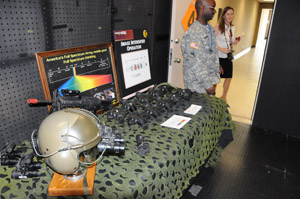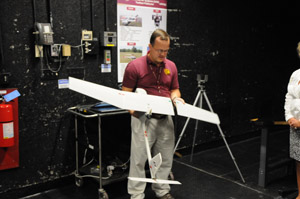Night-Vision Goggles Shed Light on STEM Initiative
As part of the U.S. Army's push to encourage the next generation of engineers and designers through STEM programs, a group of local teachers got to see first hand through the eyes of a soldier using night-vision goggles.
We own the night. It's the U.S. Army's slogan that encapsulates their strength when it comes to night-vision technology. And as part of the Army's push to encourage the next generation of engineers and designers, a group of local teachers got to see first hand through the eyes of a soldier.
Five science teachers from Fort Belvoir Elementary School attended Knowledge Day at Fort Belvoir. The event aimed to engage educators in Science, Technology, Mathematics and Engineering (STEM) programs in the hopes that they would take the knowledge and excitement back to the classroom. But this group quickly learned they wouldn't just be playing with high-tech toys-they were "investigating and experimenting" with some serious equipment.
Col. Stephanie Foster, USA, program manager for soldiers, sensors and lasers, Program Executive Office (PEO) Soldier, welcomed the group and thanked the teachers for their service. "For me, it's all about the little ones," the colonel explained. She believes finding innovative ways to make STEM subjects interesting for students will influence future leaders in the field.
 Knowledge Day kicked off in a 90-meter indoor firing facility long enough for soldiers to put M-24 sniper rifles to the test. First up, the PEO Soldier team presented the PVS-7 night-vision binocular goggle system, which is available to every soldier. The lightweight, hands-free goggles hook on to a soldier's helmet and can run on two AA batteries for more than 40 hours.
Next, the group tried on the PVS-14 monocular night-vision goggles, which cost $3,200 a pair. The Army is now migrating towards this model, which gives a soldier 20/20 vision in the dark and can upload and export images seen through the lens. Roughly 110,000 soldiers now have access to these in the field.
This smaller, more efficient model aligns with the Army's constant focus on size, weight and power. Many soldiers carry between 80 and 120 pounds on their backs, said Col. Foster. Everyone wants to add warfighter tools and technology, but no one wants to take anything away, she explained. They need innovative developers to make it easier for warfighters to function while ensuring their comfort and confidence in a variety of conditions. Col. Foster believes the visual timeline of change and innovation associated with the warfighter technology can help students understand how they can impact the field once they graduate.
Knowledge Day kicked off in a 90-meter indoor firing facility long enough for soldiers to put M-24 sniper rifles to the test. First up, the PEO Soldier team presented the PVS-7 night-vision binocular goggle system, which is available to every soldier. The lightweight, hands-free goggles hook on to a soldier's helmet and can run on two AA batteries for more than 40 hours.
Next, the group tried on the PVS-14 monocular night-vision goggles, which cost $3,200 a pair. The Army is now migrating towards this model, which gives a soldier 20/20 vision in the dark and can upload and export images seen through the lens. Roughly 110,000 soldiers now have access to these in the field.
This smaller, more efficient model aligns with the Army's constant focus on size, weight and power. Many soldiers carry between 80 and 120 pounds on their backs, said Col. Foster. Everyone wants to add warfighter tools and technology, but no one wants to take anything away, she explained. They need innovative developers to make it easier for warfighters to function while ensuring their comfort and confidence in a variety of conditions. Col. Foster believes the visual timeline of change and innovation associated with the warfighter technology can help students understand how they can impact the field once they graduate.
 Next the group held a Raven unmanned aerial vehicle (UAV), which weighs in at just 4.5 pounds. The UAV has a 60-inch wingspan and breaks down into seven small pieces that fit into the soldiers backpack. In the field, the warfighter can assemble the Raven and launch it by hand. It transmits video using two charge-coupled device cameras on the UAV's nose and operates with a controller the size of a PlayStation Portable game controller, which bodes well for the younger generations often glued to their gaming sets, remarked one of the attendees. About 2,000 of these are currently in theater.
Throughout the demonstrations, the focus stayed on educational efforts. Col. Foster said if just one student comes out of Fort Belvoir Elementary School with a desire to study STEM subjects, Knowledge Day has succeeded.
Next the group held a Raven unmanned aerial vehicle (UAV), which weighs in at just 4.5 pounds. The UAV has a 60-inch wingspan and breaks down into seven small pieces that fit into the soldiers backpack. In the field, the warfighter can assemble the Raven and launch it by hand. It transmits video using two charge-coupled device cameras on the UAV's nose and operates with a controller the size of a PlayStation Portable game controller, which bodes well for the younger generations often glued to their gaming sets, remarked one of the attendees. About 2,000 of these are currently in theater.
Throughout the demonstrations, the focus stayed on educational efforts. Col. Foster said if just one student comes out of Fort Belvoir Elementary School with a desire to study STEM subjects, Knowledge Day has succeeded.

Photo Courtesy of Douglas Graham

Photo Courtesy of Douglas Graham




Comments